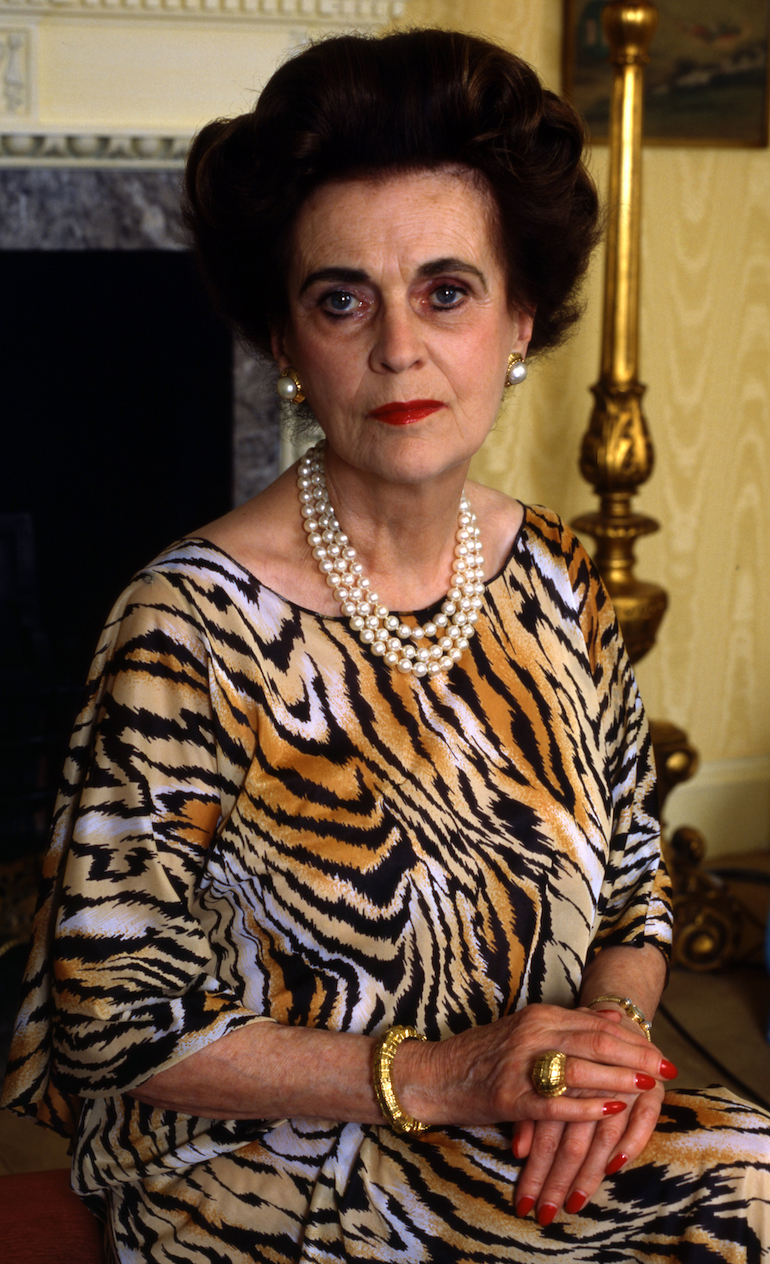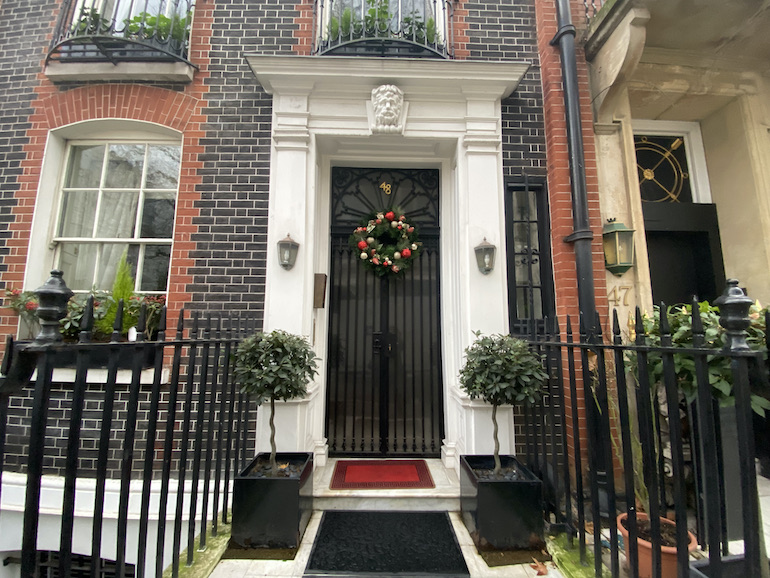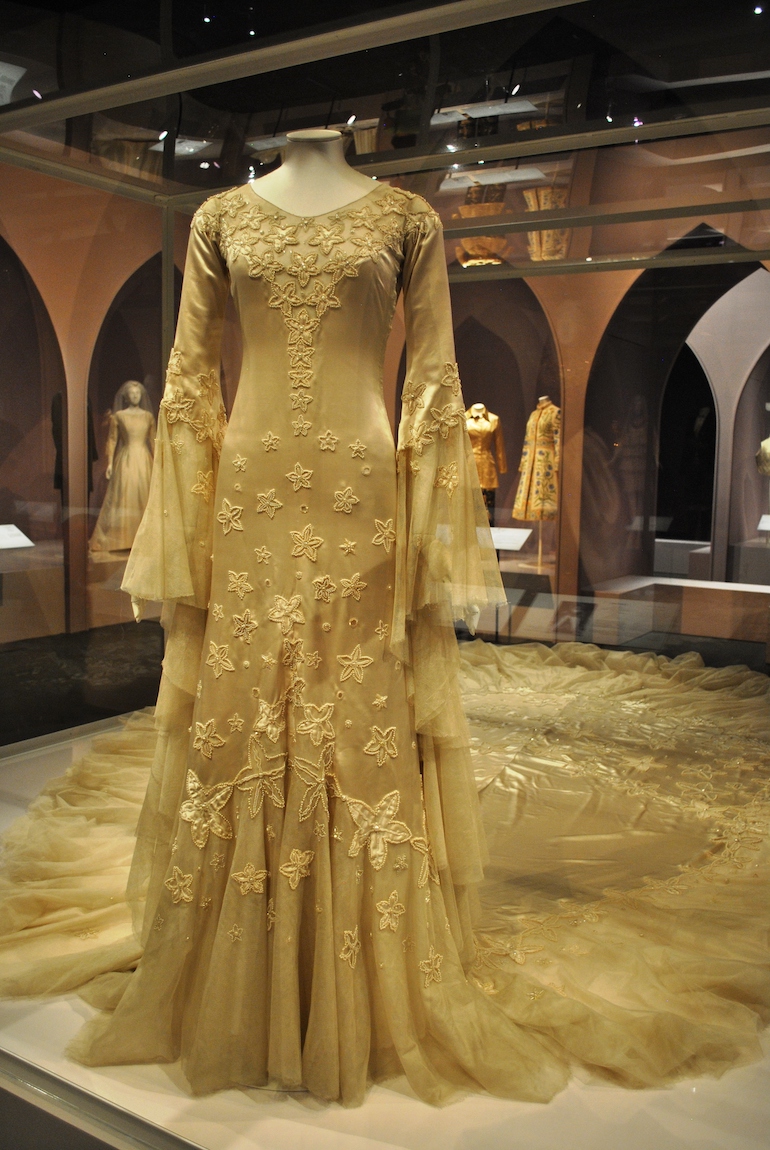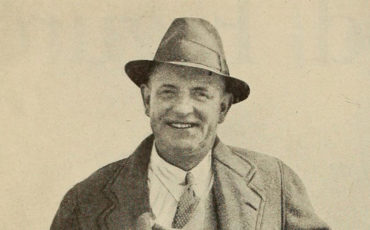Margaret, Duchess of Argyll, was a name that everyone knew at the time of her divorce in 1963 but during her lifetime she had three names, each one making her a legend, Margaret Whigham, Margaret Sweeny, and when a Duchess, Margaret Campbell.
Margaret Whigham was born in Scotland in 1912 and spent the first 13 years of her life in New York. She was a solitary only child, doted on by her father George and constantly criticised and belittled by her mother Helen who was obsessed with Margaret’s looks, even rationing her reading in case it caused her to need glasses. George had made his fortune through the manufacture of Celanese, an artificial silk, which the beautifully dressed Margaret would never have worn.
 Margaret Campbell Duchess of Argyll. Photo Credit: © Allan Warren via Wikimedia Commons.
Margaret Campbell Duchess of Argyll. Photo Credit: © Allan Warren via Wikimedia Commons.
Margaret was a keen observer of adults and an absorber of their ways. At the age of ten, she made one single friend, the child for whom the phrase ‘poor little rich girl’ was coined, Barbara Hutton, heiress to the Woolworths fortune. In her adult life, Barbara was to gift her London home, Winfield House in Regents Park, to Joseph Kennedy, US Ambassador in the UK and father of the future President, J F Kennedy.
Margaret made countless trips to London during her childhood, many to try to cure the handicap, to use her mother’s word, of her stammer. She visited the clinic of speech therapist Lionel Logue, made famous in the film The King’s Speech. She was also taken to a psychiatrist to deal with her lack of a sense of humour. Trips to the cinema to watch Charlie Chaplin films were suggested but she was cured of neither condition.
 Lionel Logue Green Plaque, 146 Harley Street, London. Photo Credit: © Sarah Wood.
Lionel Logue Green Plaque, 146 Harley Street, London. Photo Credit: © Sarah Wood.
At the age of thirteen Margaret’s family returned to live in the United Kingdom. Her looks, glossy American glamour, confident style, and position as a wealthy heiress took the lacklustre London social scene by storm. And she had style. Each day after school her chauffeur picked her up in the family Rolls Royce. He also collected her so she could take in a matinee rather than play hockey, reportedly saying to her fellow pupils ‘bye-bye you poor things, playing in your galoshes and white tunics’. Fifteen-year-old Margaret became pregnant after a holiday fling on the Isle of Wight leading to her having an illegal abortion. The father was eighteen-year-old David Niven and it was said that she adored him for the rest of her life.
1930 was the year that marked her coming out as a debutante when upper-class girls and wealthy heiresses were presented at court and engaged in a season of social events that announced their arrival on the High Society marriage market. Her coming-out party, which cost £40,000, was held audaciously on the very first day of the social season, 1 May 1930 at 6 Audley Square, and the music was provided by Bert Ambrose and his Orchestra. She went against convention by wearing a forget-me-not blue tulle dress instead of traditional white, claiming that she had ruined her original dress by accident. The dress was designed by couturier Norman Hartnell, cementing his reputation as the High Society couturier and hers as one of the best dressed young women in the country. By the end of the season, she was declared Deb of the Year, and such was her fame that she was referred to in the press as ‘The Whigham’.
 Norman Hartnell, Bruton Street in London. Photo Credit: © Sarah Wood.
Norman Hartnell, Bruton Street in London. Photo Credit: © Sarah Wood.
Margaret was presented to Queen Mary and the Prince of Wales (the future Edward VIII who rocked the Royal Family with his abdication in 1936) at Buckingham Palace. Standing behind the Queen’s throne was socialite, diplomat, and son of the Aga Khan, Aly Khan. It appeared to be love at first sight. They were formally introduced the following day and so started a great if short-lived, love affair ending when Margaret’s father refused permission for them to marry because of Khan’s Muslim faith.
Margaret, still a teenager, was the fixture of the London social scene and was frequently to be found at the Embassy Club on Old Bond Street and the 400 Club in Leicester Square. Most evenings saw her first dining with one man, pleading tiredness and getting her chauffeur to drive her home, then going out to the Embassy Club with someone else and on to a further nightclub. She later said that 1930-33 ‘was packed with gaiety and fun…It was heaven, undiluted heaven. Three parties a night.’
Her close friends included George, Duke of Kent, with whom she was said to have had an affair, society photographer Cecil Beaton and Barbara Cartland, later step-grandmother to Princess Diana. Cartland became the fifth most translated novelist in the world, famed for her extravagantly sartorial style and liberal use of false eyelashes. She was later to say of Margaret: ’She was very beautiful and every man wanted to go to bed with her, and she wanted to go to bed with every man. She didn’t have love affairs which lasted a long time. I think men found her rather boring after a time.’
Margaret’s love life read like a list of Most Eligible Bachelors. She was simultaneously engaged to both the Seventh Earl of Warwick and Max Aitken, son of newspaper tycoon Lord Beaverbrook, while having promised to marry the American financier and amateur golfer Charles Sweeny, who she chose to marry in the end. Sweeny was a Roman Catholic and, in order to marry him, Margaret took instruction into the Catholic faith at the Jesuit Church of the Immaculate Conception in Farm Street, Mayfair. Their marriage on 21 February 1933 took place at the Brompton Oratory in Knightsbridge.
 Church of the Immaculate Conception, Farm Street Church. Photo Credit: © Sarah Wood.
Church of the Immaculate Conception, Farm Street Church. Photo Credit: © Sarah Wood.
So many people wanted to get a glimpse of the glamorous bride in her Hartnell wedding dress (now in the Victoria & Albert Collection) with her handsome American husband that the traffic on the Brompton Road ground to a halt. 2,000 guests and the same number of gate-crashers crammed into the church. The event became known as ‘The Great Whigham Scramble’ and was reported on in great detail in the press.
Margaret Whigham was now Margaret Sweeny and such was her fame that P. G. Wodehouse, when anglicising some of the lyrics of the Cole Porter song You’re the Top for the West End production of Anything Goes, wrote her into musical history with the line: “You’re Mussolini, you’re Mrs. Sweeny, you’re Camembert.”
In 1934 George Whigham bought the lease of 48 Upper Grosvenor Street, Mayfair for Margaret and this was to remain her home until 1978. They became part of the world of American expats in London that included Joe Kennedy, Thelma Furness (mistress to the future Edward VIII and sister of Gloria Morgan Vanderbilt), and Wallis Simpson, for whom the King abdicated the throne.
 48 Upper Grosvenor Street in London. Photo Credit: © Sarah Wood.
48 Upper Grosvenor Street in London. Photo Credit: © Sarah Wood.
After many miscarriages, Margaret had two children, Frances and Brian, and during World War II they moved to the steel enforced Dorchester Hotel for safety. Both Margaret and Charlie became involved in the war effort. Margaret joined the American Red Cross and scandalised the US Army by insisting on wearing her signature three-strand pearls with their uniform.
She became their Entertainments Officer and attracted such stars as Bob Hope, Jack Benny, Bing Crosby, and Marlene Dietrich. It was, however, her husband who made the biggest contribution. In 1939 he suggested that American expats create a volunteer unit to fight alongside the Allies and, in spite of opposition from US General Brook who said it would threaten US neutrality, three American Eagle Squadrons were founded with decorated war hero Charlie’s uncle, Charles Sweeny, as their commander. They were to fight alongside the RAF in the Battle of Britain and in 1942 were amalgamated into the USAF.
 Eagle Squadrons Memorial, Grosvenor Square in London. Photo Credit: © Sarah Wood.
Eagle Squadrons Memorial, Grosvenor Square in London. Photo Credit: © Sarah Wood.
Around the time of the D-Day landings, Charlie met the bandleader Glenn Miller in Portsmouth and mentioned that he needed to go to Paris. Miller offered him his seat on his Norseman aircraft. Charlie declined and Miller’s plane took off but vanished without a trace. Charlie was the last person to see Glenn Miller alive.
In 1943 Margaret had an accident that some say changed her personality. When visiting her chiropodist on Old Bond Street she fell 40 feet down a lift shaft and was only just saved from being crushed by the lift. She had broken vertebrae, was given thirty stitches in her head without anaesthetic, and was told that she might never walk again. They were wrong.
By the end of the war, Margaret and Charlie’s marriage was in trouble and they divorced in 1947. Margaret enjoyed life at Upper Grosvenor Street, giving dinner parties (never cooked by her – she famously had never boiled a kettle or cooked a meal in her life). She spent time in the US and, as ever, enjoyed a hearty love life. That year she met Ian Douglas Campbell, heir to the Duke of Argyll, on a train back from Paris. He was still married to his second wife but they were eventually to marry at Caxton Hall on 22 March 1951.
It quickly became a toxic marriage that ended in 1963 with the most scandalous divorce case of the time. This is the story at the heart of the BBC miniseries A Very British Scandal, with the Duchess portrayed by Clare Foy. Central to the evidence that damned Margaret was the Polaroid photos, obviously taken with her consent, with an unnamed lover who became known in the press as ‘the headless man’. Ian stole them from her Upper Grosvenor Street home, then returned later with his daughter Jeanne, famously pinning Margaret to the bed as he told Jeanne to take the diary from her dressing table. Jeanne, who was briefly married to writer Norman Mailer, always regretted her involvement.
The divorce brought such notoriety that nearly all of Margaret’s friends abandoned her. She was estranged from her devoutly Catholic daughter for many years and the money which had not been spent by Ian disappeared in legal costs. Her adoring father George married his mistress, the trouser press heiress Jane Corby soon after his wife Helen died and Margaret became very isolated and notorious, forever ‘the Dirty Duchess’ in the eyes of the public.
Margaret was ever resourceful, however. In the 1970s she offered tours of her house which were given by her butler and included a glass of champagne for £7.50 per person. They did not, however, take off and, when the house had to be sold, she struck a deal to live in the Grosvenor House Hotel where she also entertained paying guests with a glass of Buck’s Fizz for £15.95. She wrote a gossip column for the Tatler called ‘Stepping Out with Margaret Argyll’ but this proved to be a short-lived career, not helped by her inability to spell names correctly.
 Grosvenor House Hotel in London. Photo Credit: © Sarah Wood.
Grosvenor House Hotel in London. Photo Credit: © Sarah Wood.
Eventually, her bills were paid by her children Frances and Brian who also paid for her final home, the St Georges Nursing Home in Pimlico. Ever the Grande Dame, she refused to eat lunch at midday and waited until 1 pm when it was stone cold, reasoning that only the servants had lunch at 12. She still dressed up every day and declined a private suite, saying that she enjoyed people-watching. She died on 25 July 1993 and is buried at Brookwood Cemetery near Charlie Sweeny, with whom she remained friends.
I saw her once in a cinema queue. With her heavy make-up and up-curled hair, her look was utterly of another era, for that is what she was. Margaret shone more brightly than anyone else in the interwar years, the final years of true Mayfair High Society. Life changed for everyone with the Second World War but it was in the 1960s that the cultural revolution left Margaret behind. East End boys such as photographer Terence Donovan and gangsters Ronnie and Reggie Kray were moving into Mayfair, as was the hairdresser Vidal Sassoon, who had grown up in unimaginable poverty in Shepherds Bush. He opened his salon on Bond Street and his bob hairstyle, made famous by Twiggy and Mary Quant, could not have been more different from Margaret’s fussy coiffure. Just five years after her divorce Jimi Hendrix was writing Electric Ladyland on the other side of Grosvenor Square.
Everyone said that Margaret was cold. She was spoilt and, in many respects, not very likable, but like Oscar Wilde some seventy years before, she refused to quietly go away in the face of what she saw as an injustice and her husband’s use of what we would now call revenge porn. In doing so she was damned by her private life becoming a cause celebre and not conforming to what society felt to be decent behaviour. The wealthy area of Mayfair was made for the likes of Margaret. It was developed in the seventeenth century for London’s wealthiest families where the greatest thing a woman could do was to be desirable and make a good match. Margaret may not have been entirely successful but, my word, did she have fun trying.
 1933 Norman Hartnell wedding dress worn by Margaret Whigham Sweeney, Duchess of Argyll. Photo Credit: © Elisa Rolle via Wikimedia Commons.
1933 Norman Hartnell wedding dress worn by Margaret Whigham Sweeney, Duchess of Argyll. Photo Credit: © Elisa Rolle via Wikimedia Commons.







Leave a Reply